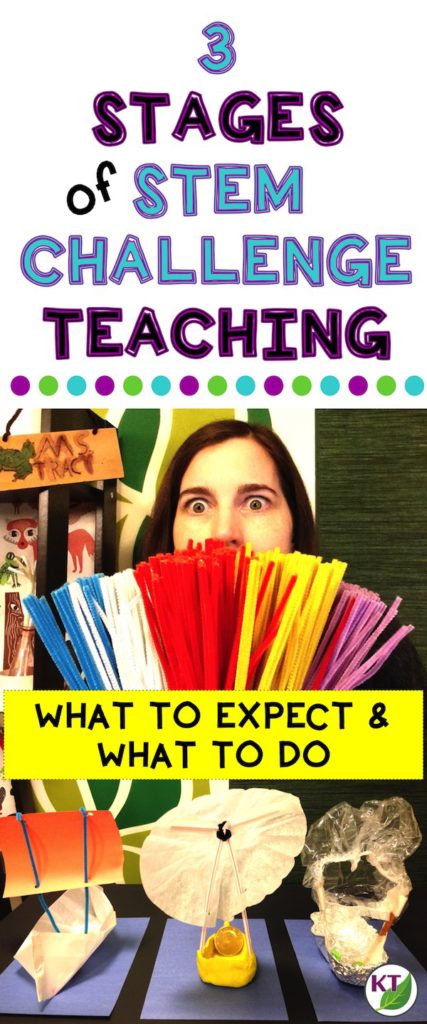Do you consider yourself a beginner, experienced, or an advanced teacher in implementing STEM Challenges? Watch to see where you are in your journey and what to add to your bag of tricks to level up your game!
Or if you prefer to read & reflect, I’ve included the video transcription directly below it.
If you have any tips or tricks to add, please share them in the comments below. As always, you can reach out with questions as well here or in the Facebook group.
WATCH ME!
Transcription
Hi, I’m Kerry from Feel Good Teaching. Today I want to talk to you about what I see as the three levels of STEM challenge educator. Beginning, intermediate, and advanced. Your purpose and your expectations of both yourself and your students will change as you move through these three levels.
I had a couple of motivations for putting this video together. The first is that I want beginners to feel a little less overwhelmed by the whole process, but also to see a path going forward on how this can resolve over time. For those of you who have already tried out STEM challenges in your classroom, I wanted to give you a few ideas to challenge yourself and your students a little bit more and up your game moving forward.
Beginner
Let’s start at the beginning. If you are just starting to implement STEM challenge with your students, your first primary goal should really be to get students used to the process. Both the engineering design process, and if you’re using my STEM challenge cycle, the steps of that and what to expect throughout a STEM challenge lesson. On top of that, you also have goals around collaboration, critical thinking and problem solving. When you’re starting out, I always recommend start with some classics like towers, boats, or bridges and the reason for that is they’re pretty straight forward, the students already understand what to do even before you give them a criteria and constraints list and they’ll be largely successful.
I always like to start with challenges where I know the students are probably going to be able to be successful, and then I start to build in that difficulty level to help them develop their perseverance as we keep going. You’re going to want to get students used to referring to the criteria and constraints lists as they’re building their designs. For these first challenges, you want to keep it simple. For the entire thing, I would say no more than three to five criteria and constraints all together. You’ll be developing your facilitation skills, you’re more likely to give a little more support than you will in the future and that’s okay, you’re learning too.
I also think this is the most appropriate time for those one and done challenges, meaning you’re not necessarily doing a second iteration where students get a chance to revise and rebuild. Hopefully, you’re only going to spend maybe one to three challenges in this beginner phase before you start getting a little bit braver and moving into that intermediate or experienced level. That’s probably where you’re going to spend most of your time during the school year.
 Intermediate
Intermediate
You’re going to be adding more complexity to your challenges, and that’s going to cause students to be more likely to meet with frustration and even failure. This is going to help them develop grit, perseverance, determination and hopefully comfort with productive failure, because this is where all our growth mindset goals come in. In this level, you’re also going to challenge yourself to include more and more extension activities, then incorporate different academic subject areas not just STEM. To set yourself up for these extensions your criteria and constraints list should be getting a little bit more robust or complex and should be well correlated to your standards. Now, that doesn’t mean you need a huge long list, just that you choose very strategically what to include in a criteria and constraints.
The more you practice this, the more meaningful your content integration will be. When you’re facilitating challenges, as students are building, you’re pulling back and giving little to no support. Most of your support is going to be emotional, or helping students work out some of their team work issues, but not really so much the design problems. It’s okay to let them fail, you just want to make sure that you help them use that information to grow in the next iteration.
Students post challenge design analysis and discussions, should be getting deeper, you should routinely, not necessarily always, be doing two iterations or more of your challenges, and finally, just for a little bit of fun, this is where I start throwing in kind of bizarre materials. If I’ve been collecting something strange, I might throw it into a completely random challenge just because I happen to have enough shower caps for every group. I know I’ve done a good job of choosing something strange when students ask, “What is that for?” My response to that question is usually something like, “I don’t know, what do you think it’s for?”
Advanced
As you near the end of the year, you might find yourself looking for just a little bit more, and if that’s the case for you, you are at the advanced level. The purposes of the intermediate level still apply, but we’re going to build on that. We want to deepen the understanding of the engineering design process, we also want to work even more on those growth mindset skills. What I’d really like when we get to this level is to help students not only be comfortable with productive failure, but to be fearless or even welcoming of it. So with that, there are a few new things I like to incorporate at this level. One thing is, allowing students to barter. The way this plays out is, I still distribute identical sets of materials to every group, and maybe about 10 minutes into the build phase, I’ll allow them to send one student to a bartering table. So, every group sends a barterer with materials, and they can sort of trade.
Another way you can have students work on their persuasive skills, is to actually give them an opportunity to try to negotiate with the teacher, and in this case, they don’t necessarily need to bring me materials they aren’t using, but they need to try to persuade me to give them a material they want. It doesn’t even necessarily have to be something that was included and I might give them 30 seconds to a minute to try to convince me, they don’t have all day, we treat it like an elevator pitch and to help them develop that grit and determination, this is when I introduce impossible challenges.
Now, this could be a challenge that we’ve already done, but maybe I give them way too few materials, or just what I think is really give the wrong set of materials. Basically, I sincerely give them a challenge that I think will fail. I have to tell you I’m wrong some of the time. Students have a tendency to really rise to the occasion. When they’re at this level, and you tell them something might be impossible, you’ll be surprised what they produce. If it turns out it was an impossible challenge, there’s a lot to reflect on there and discuss in order to figure out what pieces need to be added or what has to change for it to suddenly become possible.
Just an aside there, I have friends and family who interview people for jobs for a living, and several of them have told me that they will give the interviewee what they deem to be an impossible problem to solve, just to see how they react. I’ve said it before and I’ll say it again, the skills that we help our students develop in problem solving, critical thinking, collaboration, grit and determination, these things are going to serve them well beyond their school careers. I hope I gave you some things to consider on your STEM challenge journey. I’d love to hear from you, reach out in the comments, let me know how it’s going or if you have any questions. As always, I hope your week was packed with feel good teaching moments. See you soon.



